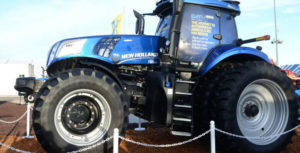Case New Holland Test Autonomous Tractor
 Case NH Autonomous Tractor. Image Courtesy of Case IH® / Case NH®
Case NH Autonomous Tractor. Image Courtesy of Case IH® / Case NH®
Case New Holland is throwing its hat in the autonomous tractor ring joining the ranks alongside rival John Deere. The company has a long history of adding technology to its popular agriculture products to both increase efficiency and reduce the manual work load of the operator. New Holland, along with International Harvester, were incorporated into the Case Global Brand (CNH) back in the late 1990s and have utilized various upgrades from the Case library of research ever since.
Case New Holland (CNH) and Case International Harvester (Case IH) began its autonomous technology pilot program back in 2016 to gauge viability and customer interest. The company that developed the technology, Autonomous Solutions Incorporated, out of Utah, partnered with Case New Holland as well as Case International Harvester to develop smart computer controlled systems for all of Case’s product line.
The “brain” behind the autonomous software is called Advanced Farm Systems (AFS) and can be adapted to existing farm machinery. The system is cabless meaning no driver needs to be present to operate the equipment. The initial design is based on a Magnum Tractor which then allows the a remote operator to monitor the equipment in real time following a per-determined route.
The system works with inputs from the operator via a remote control system. The computer then travels across the grid inputs but is much more advanced than simply following a pattern. The on-board computer automatically accounts for various changes in the width of rows based on changes in the terrain. The computer can also plot the most efficient path to save on fuel, avoid obstacles and remote shutdown upon any problems. If the user wishes they can monitor the equipment via a tablet or desktop computer and make on the fly adjustments to the pathway. The computer will automatically re-adjust to just about any changes requested by the user including speed and direction.
Safety is of the utmost importance with these autonomous vehicles. The equipment makes use of LiDAR which is a type of radar system which can track objects and other machinery in real time. The system also uses a series of cameras and sensors to make sure the path is clear at all times. If the GPS signal is lost or an object is sensed the machine will stop immediately until the obstacle is cleared or a new pathway is created. Multiple lights and sirens will also alert the remote operator of any issues in the field or if weather conditions hamper vehicle safety.
The best part about the new technology is that existing farm equipment engines can be adapted to run autonomously. There is no need to buy brand equipment which, in the agriculture world, is very expensive and hard on cash flow of smaller farming operations.
An entire farming operation could be switched over to completely autonomous operations. Multiple machines can be running at the same time even in the same field. The great thing is that technology can be adapted to run just about any farming application from tractors, combines, balers and swathers. New Holland Autonomous Tractor, Image Courtesy of Case NH®
New Holland Autonomous Tractor, Image Courtesy of Case NH®
Ideally, the technology would allow smaller farming operations to be completely employee free or complement large agricultural operations that have trouble finding labor during non-peak seasons.
Case understands that there is no two agriculture operations are exactly alike and that one solution will not fit every customer’s needs. Case developed the pilot program to incorporate five levels of autonomous usage:
1. Guidance
2. Coordination & Optimization
3. Operator Assisted Autonomy
4. Supervised Autonomy
5. Fully Autonomous
The 5 point scale was originally developed for Case in the mid 1990s with the advent of the AFS AccuGuide auto guidance technology. The auto guidance system helps farmers automatically line-up rows for seedbed planting.
The original debut of the program was launched in 2016 at the Farm Progress Show to gauge farmer’s interest. The initial reaction was a huge success and was well received by farmers of all kinds. This February Case New Holland is rolling out its second phase of the test pilot, partnering with E. & J. Gallo Winery, the largest family-owned winery in the world. E. & J. has been a loyal New Holland customer for a long time and wanted to be a part of history testing out the new NH Drive Autonomous Technology in real life conditions. The technology is going to be applied to the T4.110F tractors that work the vineyards. The goal of the program is focused on gathering soil conditions and the accuracy of the row crop planting as vehicles are deployed in the vineyards.
"New Holland Agriculture Brand President, Carlo Lambro stated, “Sustainability and innovation are in New Holland's DNA; that's how we help our customers to farm efficiently and profitably today – and anticipate the way their needs will change. We believe that specialty operations, and in particular those in the vineyard environment, could significantly benefit from the introduction of autonomous technology, in terms of productivity and sustainability. Our partner in the pilot program, E. & J. Gallo Winery, shares our commitment to innovation and sustainability in viticulture, as well as our objective of providing an autonomous solution that will benefit winegrowers around the world."
With the advent of autonomous vehicles, robot powered applications and hyperloop technology it make sense that autonomy would come to the agriculture industry. Time will tell how well the systems will be adopted but the future looks bright for manufactures and farming operations across the world.




